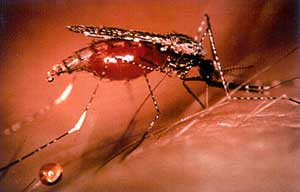
|
CULICIDAE Mosquitoes |
|
| ||||||||||||
|
These small well known insects are easily characterised by their long narrow wings and long mouthparts adapted for piercing skin and sucking out blood, as can be seen below. It is usually only the females that feed on blood as male mosquitoes do not feed at all. Males mosquitoes can usually be distinguished from females as they have bushy antennae which help them locate potential mates. Mosquitoes are known to carry serious diseases that can be passed onto humans as they feed. Malaria is one such disease that is spread in this way, but fortunately the disease is not present in Australia. However, other diseases such as Ross River virus and Murray Valley encephalitis are present in Australia and can be passed on to humans via mosquitoes.
Mosquito larvae are aquatic and can often be seen wriggling through the water of either temporary or permanent aquatic habitats. Even the smallest body of water, such as buckets or old plant pots in suburban gardens or even tin cans can be home to mosquito larvae. The larvae come to the surface of the water to breath through a syphon on the tip of their abdomen before wriggling their way back down towards the bottom of their habitat. Female mosquitoes lay their eggs on the surface of the water. When the larvae hatch they move into the water and begin feeding on detritus and plant matter in the water. Larvae develop through about four moults which may take anywhere from a few days to several weeks depending on the temperature. The pupae of mosquitoes are also aquatic and remain free swimming in the water column, rising to the surface to breathe. When fully developed the pupae rise to the surface where the back of the pupal case splits, allowing the adult to emerge above the surface of the water and fly away. For more mosquito species visit the Australian Insect Common Names - Culicidae section found here. |
